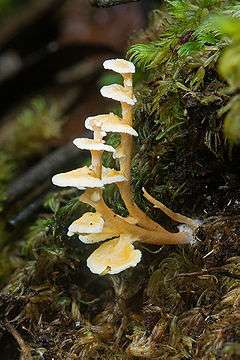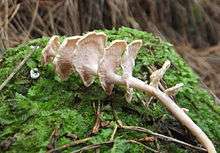Podoserpula
Podoserpula is a genus of fungi in the family Amylocorticiaceae. The genus contains two species: the type, P. pusio, commonly known as the pagoda fungus, and the "Barbie pagoda", P. miranda, officially published in 2013. Podoserpula species produce fruit bodies consisting of up to a dozen caps arranged in overlapping shelves, attached to a central axis. Its unique shape is not known to exist in any other fungi. Four varieties of P. pusio are known, which differ in their sizes, spore morphology, and distribution. The genus is known to occur in Australia and New Zealand, Venezuela, Madagascar, and New Caledonia.
| Podoserpula | |
|---|---|
 | |
| Podoserpula pusio var. pusio, Tasmania, Australia | |
| Scientific classification | |
| Kingdom: | |
| Division: | |
| Class: | |
| Order: | |
| Family: | |
| Genus: | Podoserpula D.A.Reid (1963) |
| Type species | |
| Podoserpula pusio (Berk.) D.A.Reid (1963) | |
| Species | |
Taxonomy and phylogeny
Craterellus pusio was first described by Miles Joseph Berkeley in an 1859 publication by James Hooker.[1] Otto Kuntze transferred it to the genus Merulius in 1891.[2] Until the 1960s, however, it was known as Craterellus multiplex, a species described by Mordecai Cubitt Cooke and George Edward Massee in 1889,[3] and moved to Cantharellus by Curtis Gates Lloyd in 1920.[4] In 1958, British mycologist R.W.G. Dennis collected the species in Venezuela during an expedition financed by the Percy Sladen Memorial Trust. Derek Reid, attempting to identify the species, rediscovered Berkeley's name, which had priority, and described the new genus Podoserpula for it in 1963 while simultaneously describing four varieties of it.[5][6]
Reid considered the genus allied to Leucogyrophana, then thought to belong to the family Coniophoraceae.[5] Marinus Anton Donk, in a monograph published the next year,[7] agreed and placed it close to Serpula and Coniophora; these genera are now known to represent early-diverging lineages in the order Boletales.[8] However, the white spore print and small, smooth, and hyaline spores are not characteristic of species in the Coniophoraceae.[9] In a large-scale phylogenetic analysis published in 2006, Podoserpula nested far from them in the Plicaturopsis clade, an evolutionarily related group of early-diverging members of the order Agaricales. Other taxa in this clade include Plicaturopsis and Sclerotium rolfsii.[10] The entire clade was later separated into three smaller orders, Podoserpula becoming a member of the Amylocorticiales along with mostly corticioid genera such as Amylocorticium and Serpulomyces.[11]
A new species, Podoserpula miranda, was proposed in 2009 by a group of New Caledonian mycologists for a species of that South Pacific archipelago.[12] The name was provisional (not validly published), however, as the description was in French (the code of nomenclature mandates Latin[13]) and lacked a required designation of a type specimen.[13] It was validly published in 2013.[14]
Description

The fruit bodies of Podoserpula species have an unusual form unknown in other fungi.[15] The fruit bodies, which grow to a height of 1–18 cm (0.4–7.1 in), consist of up to a dozen cup-shaped (spathulate) to kidney-shaped (reniform) caps arranged in multiple tiers and attached to a central stem. Caps are joined to the main axis by short, flattened, stem-like attachments. The variety tristis, in contrast, has caps that are more circular and appear to be pierced either centrally or off to the side. The surface of the caps is smooth and often brightly colored. The hymenium (spore-bearing surface) on the underside of the caps is pink and has a folded and corrugated surface. Close to the area of attachment between the cap and the stem-like connection to the main axis are swellings resembling warts or blisters.[5] Individual caps resemble somewhat those of the European species Plicaturopsis crispa.[9]
Podoserpula has a monomitic hyphal structure, meaning that it only contains generative hyphae, which are relatively undifferentiated and can develop reproductive structures. These hyphae are thin-walled, hyaline (translucent), branched, and up to 10 μm thick. They have distinct, often swollen, clamp connections at the septa. The spores are small, typically 2.75–6 by 2–3.5 μm, smooth, hyaline, and vary in shape from roughly elliptical to somewhat spherical. The basidia (spore-bearing cells) can be either two- or four-spored, and are club shaped, with a clamp connection at the base. Podoserpula has neither cystidia nor gloeocystidia.[5]
Podoserpula pusio var. pusio is the nominate variety. Its fruit bodies are rarely greater than 7.5 cm (3.0 in) tall. Variety austro-americana is the largest of the varieties, reaching heights up to 18 cm (7.1 in). Other than its size and geographical distribution, it is roughly similar to var. pusio. Variety ellipsospora has elongated elliptical spores typically measuring 4–5 by 2.75–3.5 μm. Variety tristis has caps whose upper surfaces are colored pale fawn, and the main axis of the fruit bodies pierces through the cap.[5]
Podoserpula miranda grows to a height of 10 cm (3.9 in). It differs from P. pusio var. pusio in having thinner flesh, up to six funnel-shaped caps whose size diminishes approaching the top, and a bright pink coloration in the folds of the hymenium.[12]
Habitat and distribution
The fruit bodies of Podoserpula pusio grow on the ground, on well-rotted stumps,[5] or among decaying tussock grass.[9] They are presumed to be saprobic, and obtain nutrients by breaking down larger organic molecules found in the soil or in decaying wood.[5] P. miranda in contrast, is thought to be ectomycorrhizal, as it appears to associate with Arillastrum gummiferum, the predominant canopy tree in the forests where it is found.[12]
The nominate variety is found in Australasia, but in 1997 it was reported in a protected area near Antananarivo in Madagascar,[16] and in 2009 on the Falkland Islands.[9] Variety ellipsospora occurs in Australia, var. tristis in New Zealand, and var. austro-americana is known from Venezuela.[5]
References
- Hooker JD. (1860). The botany of the antarctic voyage of H.M. ships Erebus and Terror in the years 1839–43 under the command of Sir James Clark Ross. III Flora Tasmaniae. 2 (1860 ed.). p. 258.
- Kuntze O. (1891). Revisio Generum Plantarum (in German). 2. Leipzig, Germany: A. Felix. p. 862.
- Cooke MC. (1889). "New Australian fungi". Grevillea. 18: 25–6.
- Lloyd CG. (1920). "Mycological Notes". Mycological Writings. 6 (62): 904–44.
- Reid DA. (1963). "Fungi venezuelani: VI (New or interesting records of Australasian Basidiomycetes: IV). Podoserpula Reid: A new genus based on Craterellus pusio Berk. (C. Multiplex Cooke & Massee)". Kew Bulletin. 15 (3): 437–45. JSTOR 4114687.
- "Podoserpula pusio (Berk.) D.A. Reid 1963". MycoBank. International Mycological Association. Retrieved 2012-09-02.
- Donk MA. (1964). "A conspectus of the families of Aphyllophorales". Persoonia. 3: 199–324.
- Binder M, Bresinsky A (2002). "Derivation of a polymorphic lineage of Gasteromycetes from boletoid ancestors" (PDF). Mycologia. 94 (1): 85–98. doi:10.2307/3761848. PMID 21156480.
- Watling R, Eggeling T (2009). "Pagoda fungus, Podoserpula pusio found in the Falklands". Field Mycology. 10 (2): 56–7. doi:10.1016/S1468-1641(10)60501-4.
- Matheny PB, Curtis JM, Hofstetter V, et al. (2006). "Major clades of Agaricales: a multilocus phylogenetic overview" (PDF). Mycologia. 98 (6): 982–95. doi:10.3852/mycologia.98.6.982. PMID 17486974.
- Binder M, Larsson KH, Matheny PB, Hibbett DS (2010). "Amylocorticiales ord. nov. and Jaapiales ord. nov.: Early diverging clades of Agaricomycetidae dominated by corticioid forms". Mycologia. 102 (4): 865–80. doi:10.3852/09-288. PMID 20648753.
- Ducoussou M, Proust S, Vigier D, Eyssartier G (2009). "Podoserpula miranda nom prov., une nouvelle espèce de champignon très spectaculaire découverte en Nouvelle-Calédonie" [Podoserpula miranda prov. name, a spectacular new fungus species discovered in New-Caledonia] (PDF). Bois et Forêts des Tropiques (in French). 302 (4): 74–5.
- "Chapter IV. Effective and valid publication. Section 2. Conditions and dates of valid publication of names. Article 34". International Code of Botanical Nomenclature (Vienna Code). International Association for Plant Taxonomy. 2006. Retrieved 2012-09-02.
- Buyck B, Duhem B, Eyssartier G, Ducousso M (2012). "Podoserpula miranda sp. nov. (Amylocorticiales, Basidiomycota) from New Caledonia". Cryptogamie, Mycologie. 33 (4): 453–51. doi:10.7872/crym.v33.iss4.2012.453.
- Roberts P, Evans S (2011). The Book of Fungi. Chicago, Illinois: University of Chicago Press. p. 432. ISBN 978-0226721170.
- Buyck B. (2008). "The edible mushrooms of Madagascar: An evolving enigma". Economic Botany. 62 (3): 509–20. doi:10.1007/s12231-008-9029-4.